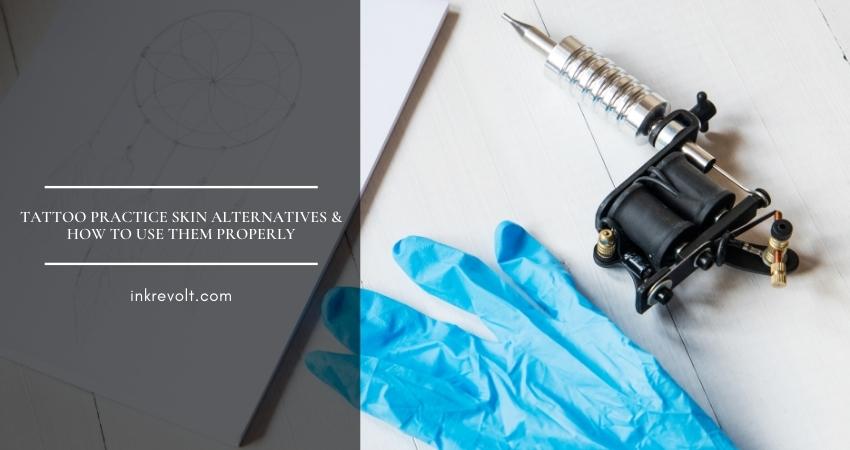Tattoo Practice Skin Alternatives: [How To Use Them Properly]
Any aspiring tattoo artist needs as much practice as possible. But synthetic practice skins will eat into your budget too fast. You’ll need cheap, preferably similar performing options for practice. But which tattoo practice skin alternatives are worth it?
Fruit peels are great replacements for practice skins. You can use pig skins if you’re looking for a close alternative. If these options aren’t to your fancy, you can always make your own cheap, but great quality synthetic skins.
You can practice on a lot of things around you when you’re starting. As you become more skilled, you’ll need to increase the difficulty, and experience working on skin-like surfaces. I’ve listed some of the most common alternatives that artists will practice on, including how to make your own artificial skin if need be.

Different Types of Practice Skins And Their Pros & Cons
| Type of Practice Skin | Pros | Cons |
|---|---|---|
| Pig Skin | Inexpensive, realistic texture | Can dry out quickly, requires more ink |
| Silicone Skin | Reusable, easy to clean, realistic texture | Can be expensive, slippery to work with |
| Synthetic Skin | Inexpensive, can be used multiple times | May not be as realistic as other types of practice skin |
| Fruit Skin | Inexpensive, widely available | Not durable or realistic, difficult to work with |
Try Working on Fruits
Fruits or fruit peels are good alternatives for synthetic skin. They have contours and textures that can mimic human skin. Bananas, apples, and oranges are good candidates for you to try working on.
Keeping the peel on the fruit and then working on it is the best idea. This way you have to deal with the way it naturally curves, like human skin. You can also take the peel off and work if you want to work your way up to it.
You can try putting stencils on the fruits and even use your tattoo machine. It’s a good method to practice not going beyond the dermis layer. Affixing the fruit in one place and then working on it will mimic how you’ll have to work with unmalleable limbs.
Oranges are the best fruits to work on, as they have porous skin. The texture will give you the most trouble to work with, as will the depth. Working with oranges as your canvas will help you master precision.
Pig Skin is a Good Alternative
Out of all the tattoo practice skin alternatives, pig skin is the closest to human skin. The skin has a similar texture, an epidermis, a dermis layer, and naturalistic curves. You can wrap pig skin around a cylinder to mimic an arm, one of the most common places that get tattooed. A big benefit is that ink will behave similarly to how it would behave on human skin.
Sourcing pig skin isn’t that hard either. You can simply ask a butcher to provide the skin for you. You can also specify how much and what size you need.
Pig skin is considered to be the best practice skin alternative by many artists. However, pig skin has its downsides, and these can be absolute deal-breakers. Here are some issues that you’ll have to deal with if you choose pig skin.
- You’ll need fresh pig skin. Dried pig skin works, but you’ll lose all the qualities that you’re paying for. You can expect pig skin to hold up to one hour before it starts losing its integrity.
- The cost is the highest of all practice skins. You’ll have to hash out $6 for a $2 equivalent size of synthetic skin. Sourcing from a local butcher can drastically reduce the price, however.
- While it is common practice, you can find working with pig skin repulsive. It may go against your morals if you’re not okay with using animal products.
The cost and the need to keep it fresh are both big issues when it comes to pig skin. And if you have no desire to take part in animal cruelty, you’ll want nothing to do with this option. Then, why not make your own practice skin?
Additional Read: Can you practice tattooing on a potato?
Make Your Own Synthetic Practice Skin
You can make your own synthetic practice skin at home. It isn’t as costly as buying synthetic or pig skin. But you’ll need a lot of elbow grease and patience to make it happen. However, if you go through with it, you’ll be able to produce high-quality synthetic skin in bulk.
To make your own practice synthetic skin or fake tattoo skin, you’ll need these ingredients.
- Elmer’s glue.
- Plastic bag.
- 1/4th of a cup of cornstarch or flour.
- 1/3rd of a cup of warm water.
- Flesh paint.
- Bowl.
- Rolling pin.
- Fork or whisk.
As you can guess from the ingredients, the produced skin will have a similar quality to a rubber-based synthetic skin. You can follow this process to make the skin.
- Mix the warm water and cornstarch or flour. Use the whisk to mix it till the mixture turns firm and thick, but it’s still malleable. You can adjust the amount of cornstarch or flour if you need to.
- Use the rolling pin to roll the mixture into a flat sheet. Make the sheet thin so that it’s easier to work with.
- Take the plastic bag, and pour in Elmer’s glue. Mix a few drops of the flesh paint to color the mixture. Mix the glue well with the color using the whisk.
- Once the mixture is prepared, close up the plastic bag and cut one corner to create a piping bag. Pipe the mixture onto the flat sheet.
- Knead the produced ‘dough’ to make sure that all the ingredients are evenly mixed.
- Once mixed, roll the ‘dough’ into a flat sheet again. Note how thin or thick you’re making the sheet. Making the sheet thin will help you practice how deep your needle should go to reach the dermis layer.
- Cut up the sheet as you need and leave it out to dry.
Once the artificial skin is dry, it’ll produce a texture and thinness that’ll help you control your needle depth and deal with the texture. You can produce this skin for quite cheap, and make exactly as much as you need. So, this may be your best option if you don’t mind putting in the work.
Although you can’t exactly practice on human skin with your tattoo gun, you still have other options that you can try. Working with practice skins will serve you fine, but you won’t experience a fidgety client or being unable to manipulate the skin as you need to. So, you’ll need some hands-on experience.
Read More: Cleaning Fake Tattoo Skin Befor use
Silicone Skin
Silicone skin is a synthetic material that closely mimics the texture and feel of human skin. It is reusable and easy to clean, making it a cost-effective choice for those who want to practice multiple times. However, silicone skin can be more expensive than other types of practice skin, and some artists find it too “slippery” to work with.
Tips for Using Tattoo Practice Skin Alternatives
- Experiment with Different Techniques: Using tattoo practice skin alternatives is a great opportunity to experiment with different techniques and styles without the pressure of working on a client. Trying out different techniques can help build confidence and improve overall skill.
- Use Different Types of Practice Skin: Using different types of practice skin can help an artist develop a feel for different skin textures and thicknesses, preparing them for a variety of skin types they may encounter when working on actual clients. Also bony areas and areas with more fatty tissue have different texture and thickness.
- Seek Feedback from Experienced Tattoo Artists: Receiving feedback from experienced tattoo artists can help an aspiring artist identify areas for improvement and refine their technique. This can be done by attending workshops or reaching out to more experienced artists for guidance.
How to Practice on Actual Skin Safely?
Practicing on a person’s skin can give you experience that you won’t have otherwise. It’ll introduce you to some core difficulties when working with clients. If you practice on people with safe options, you’ll have the following benefits.
- You’ll have to convince a person to be your canvas, and possibly for a good length of time. That’ll help you learn how to market your craft to clients.
- People fidget and move around. It’s a natural action that they can’t help. You’ll learn how to deal with these minute but unexpected motions.
- Real skin isn’t exactly malleable, so you can’t just turn over a limb if you need. You’ll have to angle yourself so you can get to the inaccessible niches. Practicing will get you used to this issue.
When it comes to working on people for practice, two options stand out –
- Henna dye.
- Removable non-toxic markers.
1. Henna Dye
Henna is a natural, plant-based dye that can create long-lasting tattoos on the skin. The dye leaves color pigments that can last for a couple of months. It’s completely harmless, and other than a rare allergic reaction, it really won’t cause any complications.

To create a henna tattoo, you’ll have to apply the dye onto the skin using a piping nozzle. Line variation and width matter greatly, and you can control them. You can use this opportunity to master creating thin lining and highly complex designs.
Leaving the dye on the skin for a few minutes and then washing it off will produce the tattoo. The longer you keep it on, the stronger the shade will get. It’ll also affect how long the tattoo will last. If you don’t want the tattoo to last too long, then wash it off early.
2. Removable Non-toxic Markers
On the other hand, using a removable, non-toxic marker will allow you to remove it instantly. You don’t have to deal with the hassle of carrying a tattoo around. However, you won’t have much room for controlling your line variation. Still, you can practice the tattoo art styles that are difficult for you with the method first.
Wrapping Up
The best tattoo practice skin alternatives for you to try would be orange peels and homemade synthetic skin. These can save you a lot of money and give you lots of material to practice with.
However, don’t ignore practicing with henna or markers just because you can’t use your tattoo machine. You’ll have a better understanding of interacting with a client through these methods.
